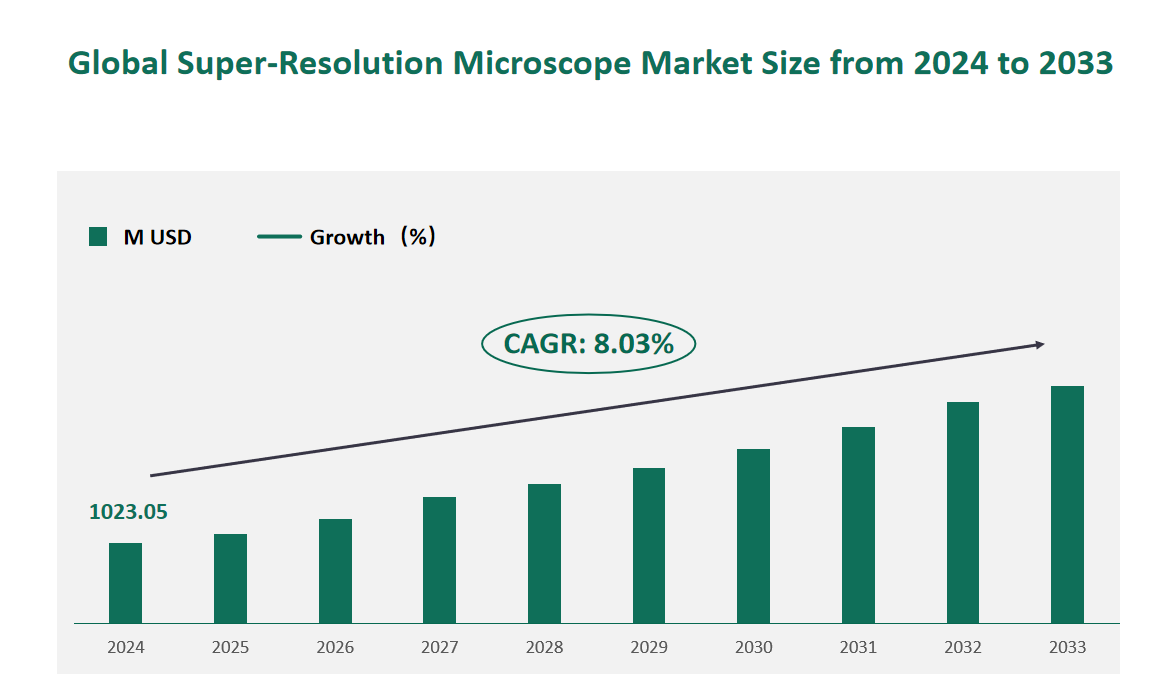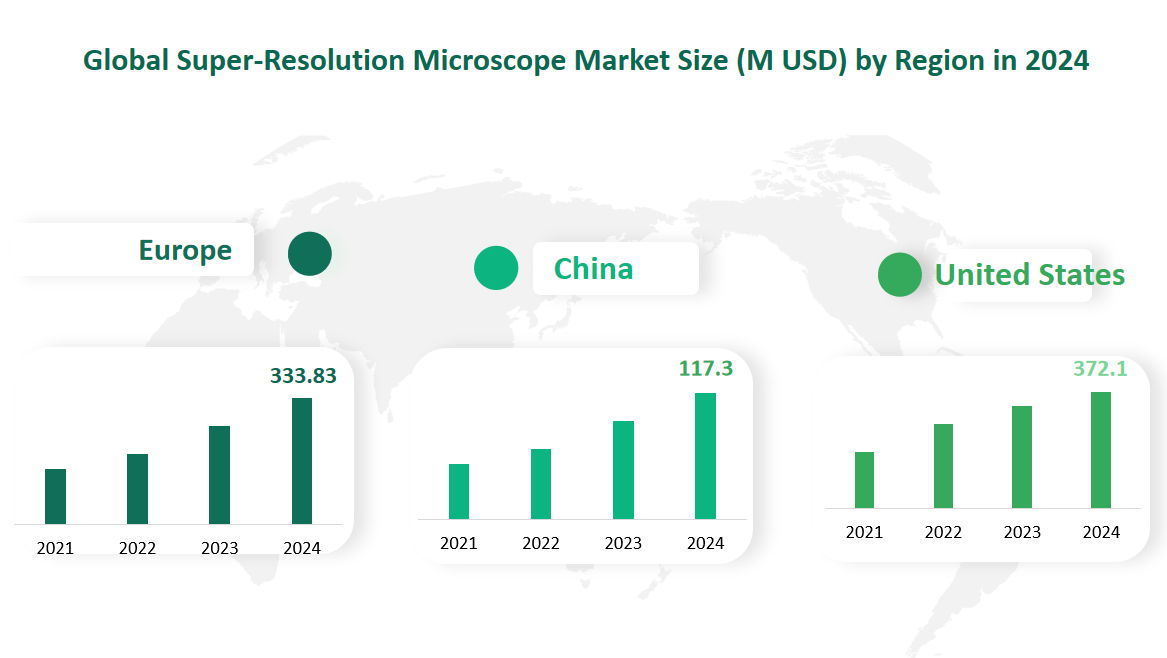1 Global Super-Resolution Microscope Market Size (Value) and CAGR (2024-2033)
In 2024, the global Super-Resolution Microscope market was valued at USD 1023.05 million, with a CAGR of 8.03% from 2024 to 2033.
Super-resolution microscopy (SRM) encompasses multiple techniques that achieve higher resolution than traditional light microscopy. Scientists and technicians can use powerful super-resolution microscopy techniques to image living samples well beyond the established theoretical limit, allowing the study of far-ranging biological phenomena.
Figure Global Super-Resolution Microscope Market Size (M USD) and CAGR 2024-2033

2 Super-Resolution Microscope Market Drivers and Opportunities
The Super-Resolution Microscope market is experiencing rapid growth, driven by a confluence of factors that are reshaping the landscape of microscopic imaging. One of the primary drivers is the advancements in biotechnology and life sciences, where the demand for high-resolution imaging is crucial for understanding cellular and molecular structures. The pursuit of novel discoveries in fields such as virology, immunology, neuroscience, and cancer research has created a surge in the demand for super-resolution microscopes that can provide insights at the nanoscale.
Technological innovations have made super-resolution microscopy techniques like STED, PALM, and STORM more accessible and affordable, which in turn has broadened their application beyond academic research to commercial and industrial sectors. The opportunity for market expansion is further amplified by the growing investment in R&D by governments and private entities, aiming to leverage these advanced imaging tools for new applications in material science, semiconductors, and pharmaceutical development.
Another significant opportunity lies in the digital transformation within the industry. The integration of IoT, AI, and data analytics is enabling manufacturers to offer smarter, more efficient, and automated super-resolution microscopes. This not only enhances the user experience but also opens up new avenues for remote diagnostics and collaborative research across geographical boundaries.
The market is also presented with opportunities from emerging economies, where the investment in education, scientific research, and healthcare infrastructure is on the rise. These regions offer a vast potential for market penetration as they seek to equip their research and diagnostic facilities with cutting-edge technology.
3 Super-Resolution Microscope Market Challenges and Restraints
Despite the promising growth prospects, the Super-Resolution Microscope market faces several challenges and restraints. The high cost of R&D and the complexity of the technology involved create significant barriers to entry for new players. The market is characterized by a high degree of concentration, with a few major players dominating the global scene, which can limit competition and innovation.
Another challenge is the technical complexity and the need for specialized expertise to operate super-resolution microscopes, which can restrict their adoption in less developed regions or among smaller research facilities with limited budgets.
The market also faces the challenge of keeping pace with the rapid evolution of technology, requiring continuous investment in product development to stay competitive. There is also a need for standardization and harmonization of technical specifications to ensure interoperability and compatibility across different systems and platforms.
4 Global Super-Resolution Microscope Market Size and Share by Type in 2024
The global Super-Resolution Microscope market is characterized by a variety of cutting-edge technologies, each offering distinct advantages in the field of microscopic imaging. In 2024, the market revenue for these different types is expected to reflect the diverse applications and preferences within the scientific community.
PALM (Photoactivated Localization Microscopy): PALM is a technique that utilizes photoactivatable fluorescent proteins to achieve super-resolution imaging. It allows for the localization of single molecules with high precision, providing insights into the nanoscale organization of cellular structures. In 2024, the revenue for PALM is forecasted to reach USD 144.08 million, showcasing its significant share in the market.
FPALM (Fluorescence Photoactivation Localization Microscopy): Similar to PALM, FPALM enhances the resolution of fluorescence microscopy by imaging only a sparse subset of molecules at a time. This method is adept at identifying and localizing individual fluorescent molecules within a sample. The revenue for FPALM in 2024 is estimated at USD 77.27 million, indicating its role in the super-resolution market.
STORM (Stochastic Optical Reconstruction Microscopy): STORM is a method that involves the stochastic switching of fluorophores between dark and bright states, allowing for the reconstruction of images with super-resolution. It is particularly useful for dynamic studies of cellular structures. The market revenue for STORM in 2024 is projected to be USD 176.03 million, highlighting its growing importance in the field.
SSIM/SIM (Structured Illumination Microscopy/Spectral Structure Illumination Microscopy): SSIM/SIM improves resolution by illuminating the sample with structured light patterns, which are then analyzed to reconstruct a high-resolution image. This technique is known for its ability to image thick samples and live cells. The revenue for SSIM/SIM in 2024 is expected to reach USD 275.17 million, reflecting its widespread adoption.
STED (Stimulated Emission Depletion): STED microscopy uses a depletion beam to reduce the effective point spread function, allowing for the imaging of structures below the diffraction limit. It is a powerful tool for super-resolution imaging in various biological and material science applications. STED is anticipated to generate a revenue of USD 216.83 million in 2024.
Table Global Super-Resolution Microscope Market Size and Share by Type in 2024
Type | Market Size (M USD) 2024 | Market Share 2024 |
PALM | 144.08 | 14.08% |
FPALM | 77.27 | 7.55% |
STORM | 176.03 | 17.21% |
SSIM/SIM | 275.17 | 26.90% |
STED | 216.83 | 21.19% |
Others | 133.65 | 13.06% |
5 Global Super-Resolution Microscope Market Size and Share by Application in 2024
The Super-Resolution Microscope market is segmented into various applications, each with its own unique requirements and contributions to the scientific community.
Semi-Conductor: This application sector utilizes super-resolution microscopes for the inspection and analysis of semiconductor materials and devices at the nanoscale. It is crucial for quality control and the development of new semiconductor technologies. The revenue for the semi-conductor application is projected to be USD 106.47 million in 2024.
Research Labs and Academia: Super-resolution microscopes are vital in academic and research laboratory settings for advanced studies in cell biology, nanotechnology, and materials science. This segment is expected to generate a revenue of USD 258.99 million in 2024, highlighting its significant role in driving scientific discoveries.
Life Science: This application involves the use of super-resolution microscopes in biological research, including the study of cellular structures, protein interactions, and disease mechanisms. The life science sector is the largest consumer, with a projected revenue of USD 579.32 million in 2024, reflecting the critical need for high-resolution imaging in biological research.
Table Global Super-Resolution Microscope Market Size and Share by Application in 2024
Application | Market Size (M USD) 2024 | Market Share 2024 |
Semi-Conductor | 106.47 | 10.41% |
Research Labs and Academia | 258.99 | 25.32% |
Life Science | 579.32 | 56.63% |
Others | 78.28 | 7.65% |
6 Global Super-Resolution Microscope Market Size by Region in 2024
The global Super-Resolution Microscope market is distributed across various regions, each with its own development status and market potential. In 2024, the market revenue for these regions is expected to reflect the diverse economic conditions, research investments, and industrial demands.
United States: As a leader in scientific research and technology development, the United States dominates the market with a projected revenue of USD 372.1 million in 2024. The strong presence of research institutions and high-tech industries drives the demand for super-resolution microscopes.
Europe: With a strong foundation in life sciences and a robust academic community, Europe is expected to generate a revenue of USD 333.83 million in 2024. The region’s investment in research and development contributes significantly to the market growth.
China: The market in China is rapidly expanding due to increasing investments in R&D and the growth of high-tech industries. The revenue for China is projected to be USD 117.3 million in 2024, indicating the country’s emergence as a significant player in the global market.
Japan: Known for its advanced technology and electronics industry, Japan is expected to contribute a revenue of USD 111.26 million in 2024. The country’s focus on quality and precision drives the demand for super-resolution microscopes.
India: India’s market is growing, supported by its expanding pharmaceutical and biotechnology sectors. The revenue for India is projected to be USD 10.6 million in 2024, reflecting the country’s efforts to strengthen its research capabilities.
Southeast Asia: The region is experiencing growth due to increasing foreign investments and industrial development. The revenue for Southeast Asia is expected to be USD 12.06 million in 2024.
Latin America: Latin America’s market is projected to generate a revenue of USD 24.01 million in 2024, with Brazil being a key contributor due to its growing scientific research sector.
Middle East and Africa: These regions are expected to contribute a combined revenue of USD 13.55 million in 2024, with the Middle East’s oil-rich economies investing in high-tech equipment for various applications.
Figure Global Super-Resolution Microscope Market Size by Region in 2024

7 Major Players in Global Super-Resolution Microscope Market
7.1 Leica Microsystems
Company Profile: Leica Microsystems, established in 1997 and headquartered in Wetzlar, Germany, is a leading designer and manufacturer of opto-digital imaging solutions in the field of microscopy. The company has a global presence, with major plants and product development sites around the world, and is represented in over 100 countries.
Business Overview: Leica Microsystems is renowned for its compound and stereo microscopy, digital microscopy, confocal laser scanning microscopy with related imaging systems, electron microscopy sample preparation, and surgical microscopes. The company’s commitment to innovation and precision has solidified its position as a market leader.
Product Profiles: Leica offers a range of super-resolution microscopes, including the STELLARIS platform, which combines STED technology for nanoscale imaging. Their products are designed to study subcellular structures and dynamics with unparalleled detail, enabling novel discoveries in fields such as virology, immunology, neuroscience, and cancer research.
Financial Performance: In 2021 and 2022, Leica Microsystems reported revenues of USD 186.66 million and USD 201.51 million, respectively, with a gross margin hovering around 65-68%.
7.2 Carl Zeiss AG
Company Profile: Carl Zeiss AG, founded in 1846 and based in Oberkochen, Germany, is a global leader in the manufacturing of microscopes and optical systems. The company’s extensive product range and cutting-edge technology have made it a household name in the field.
Business Overview: ZEISS Microscopy is at the forefront of providing microscope solutions for life sciences, materials research, routine and industry markets. The company’s commitment to excellence and innovation has kept it at the pinnacle of the industry.
Product Profiles: Carl Zeiss AG’s super-resolution microscope, the Elyra 7 with Lattice SIM², is designed to double the conventional SIM resolution, allowing for the discrimination of the finest sub-organelle structures. This product exemplifies the company’s dedication to pushing the boundaries of microscopy.
Financial Performance: Carl Zeiss AG’s revenues for 2021 and 2022 were USD 168.20 million and USD 177.07 million, respectively, with gross margins maintaining between 65-67%.
7.3 Nikon Corporation
Company Profile: Nikon Corporation, established in 1917 and headquartered in Tokyo, Japan, is a multinational corporation specializing in optics and imaging products. Nikon is recognized as one of the world’s leading suppliers of opto-electronics and precision technology-based solutions.
Business Overview: Nikon’s precision equipment business spans a wide range of products and solutions, including super-resolution microscopes. The company’s focus on innovation and customer trust has been instrumental in its success.
Product Profiles: Nikon offers a range of super-resolution systems, such as the N-SIM S, designed for high-speed imaging applications and single-molecule level imaging needs. These systems are renowned for their ability to capture fast biological processes at twice the spatial resolution of conventional light microscopes.
Financial Performance: Nikon Corporation’s revenues for the last two years were USD 132.19 million in 2021 and USD 147.29 million in 2022, with gross margins ranging from 64-65%.

